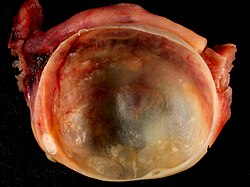Ovarian cyst
| Ovarian cyst | |
|---|---|
 |
|
| A simple ovarian cyst of most likely follicular origin | |
| Classification and external resources | |
| Specialty | Gynecology |
| ICD-10 | N83.0-N83.2 |
| ICD-9-CM | 620.0-620.2 |
| DiseasesDB | 9433 |
| MedlinePlus | 001504 |
| eMedicine | med/1699 emerg/352 |
| MeSH | D010048 |
An ovarian cyst is a fluid-filled sac within the ovary. Often they cause no symptoms. Occasionally they may produce bloating, lower abdominal pain, or lower back pain. If the cyst either breaks open or causes twisting of the ovary severe pain may occur. This may result in vomiting or feeling faint. The majority of cysts are, however, harmless.
Most ovarian cysts are related to ovulation being either follicular cysts or corpus luteum cysts. Other types include cysts due to endometriosis, dermoid cysts, and cystadenomas. Many small cysts occur in both ovaries in polycystic ovarian syndrome. Pelvic inflammatory disease may also result in cysts. Rarely cysts may be a form of ovarian cancer. Diagnosis is undertaken by pelvic examination with an ultrasound or other testing used to gather further details.
Often cysts are simply observed over time. If they cause pain, medications such as paracetamol (acetaminophen) or ibuprofen may be used. Hormonal birth control may be used to prevent further cysts in those who are frequently affected. However, evidence does not support birth control as a treatment of current cysts. If they do not go away after several months, get larger, look unusual, or cause pain they may be removed by surgery.
Most women of reproductive age develop small cysts each month. Large cysts that cause problems occur in about 8% of women before menopause. Ovarian cysts are present in about 16% of women after menopause and if present are more likely to be cancer.
...
Wikipedia
